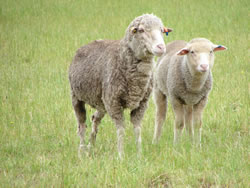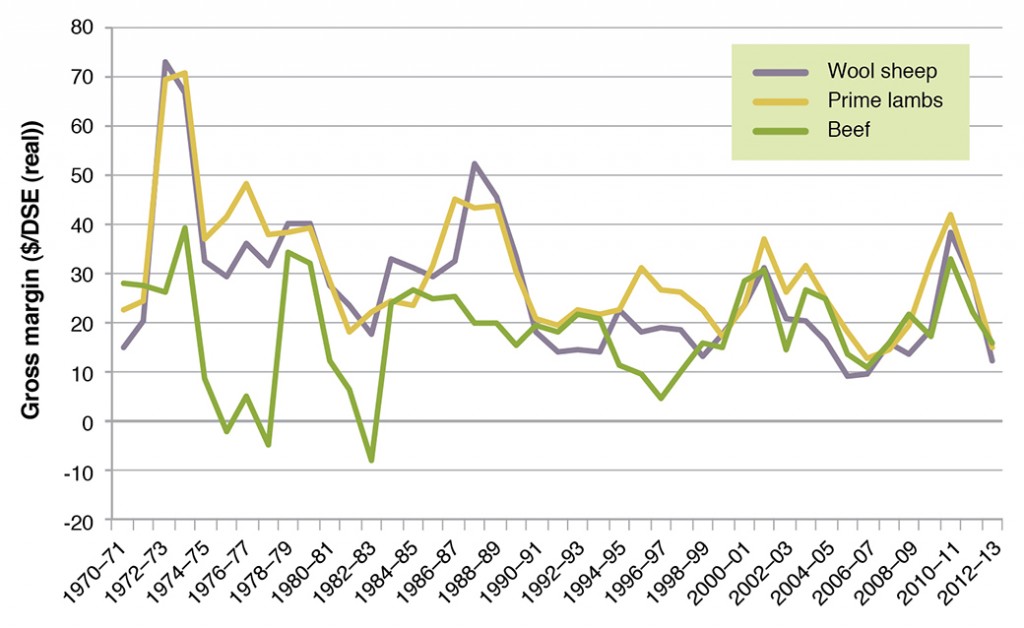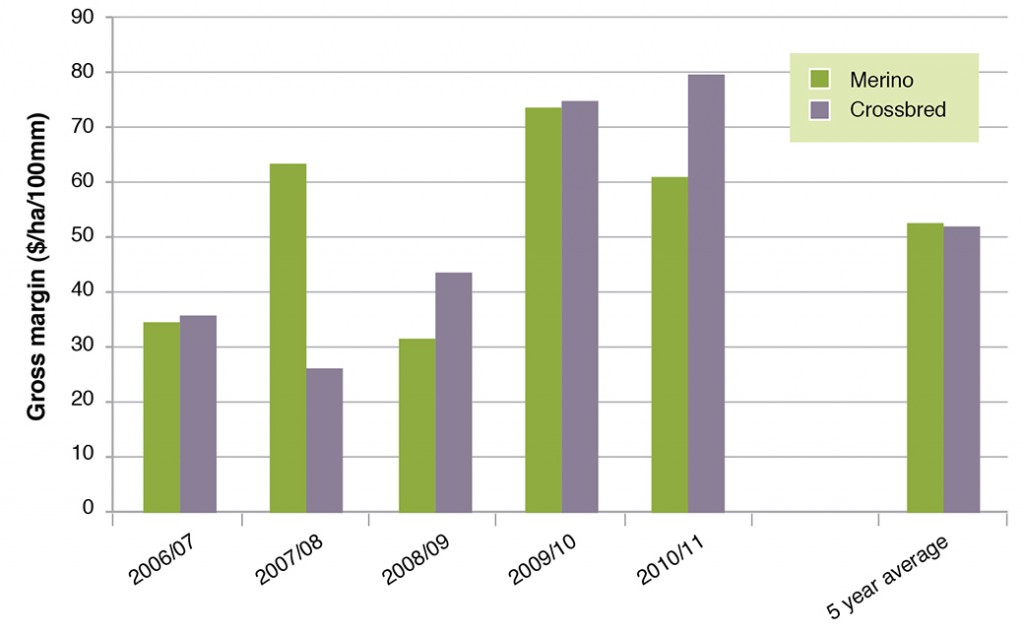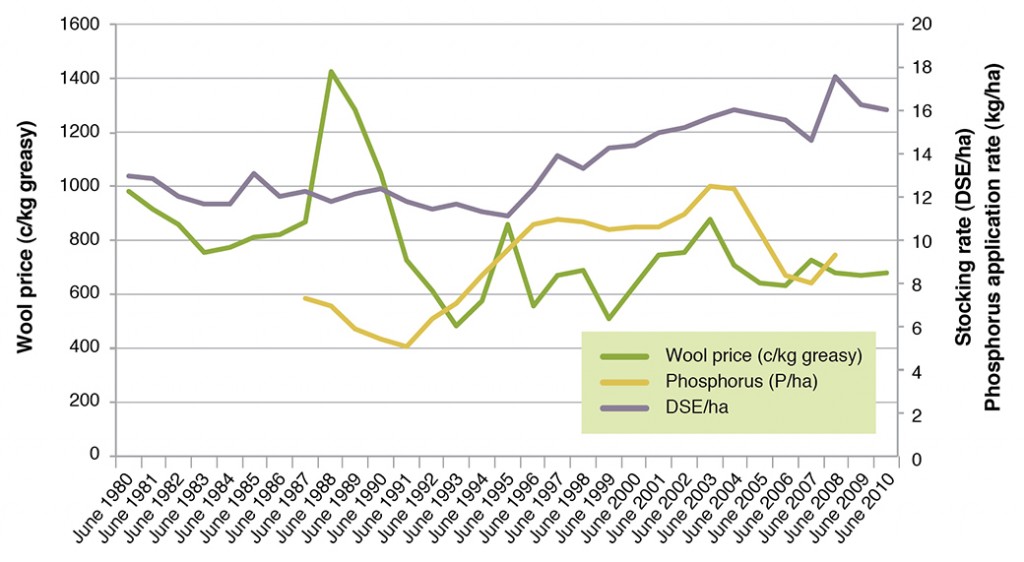South West Victoria (Lower) – Livestock systems and Industry benchmarks
South west Victoria represents 25% (~3 million ha) of Victoria but carries over half of the Victorian sheep flock and gross value of sheep and lambs. Fine wool production was the major enterprise in the 20th century, but recent low wool prices and high lamb prices has seen a swing to lamb production. The region now runs 35% of Victorian flocks with greater than 1000 prime lamb ewes.

There has also been a large increase in cropping and dairying in the region. While these changes have altered the enterprise composition of many farms, Merino based enterprises for both wool and prime lamb production are still very commonin the region.
There has been a change to late winter-spring lambing, particularly for Merino enterprises, with July- August the most common lambing time. Prime lambs systems using first cross ewes tend to lamb in June and July.
South west Victoria has 39% of the state’s beef cattle. The industry is characterised by cow/calf breeding systems producing vealers or weaners that are grown out for the domestic supermarket trade or finished in feedlots for the export market. There is also a significant trading operation on many farms for the domestic and export markets.
There has been a swing from autumn calving to spring calving because there is less reliance on supplementary feeding through winter and generally a lower cost of production. The decision to go with autumn or spring calving should be based on the markets being targeted and making the best use of feed supply and feed demand.
Similarly, here has been a change to late winter-spring lambing, particularly for Merino enterprises, with August the most common lambing now very common. Prime lambs systems using first cross ewes tend to lamb earlier during June and July.
South West Victoria industry benchmarks
The data presented below is mainly taken from the Livestock Farm Monitor Project that is available from the Agriculture Victoria website. The Livestock Farm Monitor Project surveys selected farms for physical and financial information across Victoria. Data is presented for the 10 year average (2001-2011). Farms included in the dataset cover the area bounded by Dergholm, Ararat, Ballarat, Woolsthorpe and Bessiebelle.
Benchmarks should always be interpreted in the context of the data collected, and when comparing your own situation to the benchmarks, consideration should be given to variables such as climate, soils and enterprise setup.
Also note, for the analysis of particular livestock industries below, only the relevant enterprises are shown which reduces the number of properties.
Whole farm analysis
The number of participants varies between years but is usually about 38 farms. Table 1 shows physical and financial data for farms in the south west averaged over 2001-2011. The Top 20% are those farms with high profitability per effective hectare, based on operating profit as $/ha. Enterprise mix is not available for the 10 year average but for 2010-11 the average was 42% wool sheep, 36% prime lambs, 13% cattle and 9% cropping. In this year, the top 20% producers ran more prime lambs and less cattle.
Table 1. Differences between average and high profitability farms in south west Victoria (average 2001-2011)
| Farm parameter | Average all farms | Top 20% |
| Area (ha) | 1,031 | 923 |
| Annual rainfall (mm) | 676 | 691 |
| Stocking rate (DSE/ha) | 15.7 | 18 |
| Stocking rate (DSE/ha/100 mm rainfall) | 2.4 | 2.7 |
| Labour efficiency (DSE/labour unit) | 7,409 | 8,612 |
| Phosphorus application (kg P/ha) | 10.4 | 12.6 |
| Gross Income ($/ha) | 639 | 812 |
| Enterprise costs ($/ha) | 248 | 249 |
| Overhead costs ($/ha) | 124 | 113 |
| Net Income ($/ha) | 268 | 450 |
| Owner/Operator allowance ($/ha) | 78 | 68 |
| Operating profit ($/ha) | 179 | 372 |
| Return to assets (%) | 3.2 | 7.9 |
These results show that the most profitable farms:
- run a higher stocking rate;
- apply more fertiliser;
- run more stock per labour unit;
- achieve these without an increase in operating costs.
Farm enterprise comparison
[expand title=” ” swaptitle=” ” tag=”h4″ elwraptag=”div” elwrapclass=”expend-collapse-wrapper”]
Figure 1 shows the profitability of the livestock enterprises (wool, lamb and beef) over the past 42 years as Gross Margin per DSE in real values in the south west. This illustrates the reasons for a greater emphasis on prime lamb production compared to wool as was the case in the 1970’s and 80’s.

Enterprise analysis
Wool Sheep
Table 2 shows the average characteristics of wool producing enterprises for the 10 year period 2001-11. The top 20% of farms are ranked by operating profit per effective hectares.
Table 2. Production and financial characteristics of average and high profitability wool enterprises in south west Victoria 2001-11 average.
| Farm parameter | Average all farms | Top 20% |
| Stocking rate (DSE/ha) | 15.1 | 17.3 |
| Marking (%) | 75 | 76 |
| Wool per head (kg clean) | 3.7 | 3.7 |
| Wool per hectare (Kg) | 37 | 43 |
| Fibre diameter (micron) | 18.9 | 19 |
| Net wool price, clean ($/kg) | $10.57 | $11.29 |
| Sheep sale price ($/head) | $54 | $58 |
| Pasture costs; $/ha, ($/DSE) | $50 ($3.30) | $54 ($3.12) |
| Supplementary feed; $/ha, ($/DSE) | $64 ($4.24) | $49 ($2.83) |
| Animal health; $/ha, ($/DSE) | $26 ($1.72) | $29 ($1.68) |
| Gross margin ($/DSE) | $19 | $27 |
| Gross Margin ($/ha) | $273 | $455 |
| Gross Margin ($/ha/100mm rainfall) | $43 | $74 |
Characteristics of the most profitable wool enterprises;
- More profitable operations run a higher stocking rate, achieve the same production per head but with greater value for product sold which leads to higher profitability per head.
- There is no difference in reproductive performance of high and average wool farms.
Prime lambs
Table 3 shows the key characteristics of all prime lamb enterprises for 2001-11. This covers a range of ewe breeds; Merinos, Crossbreeds and self-replacing Composites. The top 20% of farms are ranked by operating profit per effective hectares.
Table 3. Production and financial characteristics of average and high profitability prime lamb enterprises in south west Victoria, 2001-11 averages.
| Farm parameter | Average all farms | Top 20% |
| Stocking rate (DSE/ha) | 16 | 18.8 |
| Marking (%) | 102 | 104 |
| Lamb production carcass weight (kg/ha) | 103 | 143 |
| Wool (kg/ha greasy) | 35 | 42 |
| Net wool price, greasy ($/kg) | $4.65 | $5.01 |
| Average lamb carcass price ($/kg) | $4.23 | $4.57 |
| Pasture costs; $/ha, ($/DSE) | $64 ($4.00) | $74 ($3.94) |
| Supplementary feed; $/ha, ($/DSE) | $46 ($2.88) | $45 ($2.39) |
| Animal health; $/ha, ($/DSE) | $26 ($1.63) | $31 ($1.65) |
| Gross margin ($/DSE) | $25 | $37 |
| Gross Margin ($/ha) | $394 | $656 |
| Gross Margin ($/ha/100mm rainfall) | $61 | $104 |
As for wool sheep, more profitable operations run a higher stocking rate, achieve similar production per head but with greater value for product sold. Highly profitable properties spend more on pastures per hectare. As there is a diversity of ewe breeds and prime lamb systems in the analysis, some of the reason for little difference in lambing percentages may be due to a number of Merino flocks with high wool returns and low lambing percentages (as was the case in in 2010/11). This illustrates the contribution of wool to returns.
Figure 2 shows average Gross Margins as $/ha/100mm rainfall for the last 5 years for enterprises that have Merino ewes as the ewe base and those that run Crossbred ewes. Composite or obvious self-replacing meat enterprises are not included due to small numbers. Whilst the five year average shows little difference in enterprise gross margins/ha/100 mm, there is considerable variability between years. Also, there is as much variability within these systems in any one year as between enterprises. There are some very profitable prime lamb enterprises that have Merino ewes as the base and some that run well below average. The same is the case for Crossbred ewe systems in this data.

Beef Cattle
The key characteristics of beef cattle herds surveyed for the same period (2001-2011) are shown in Table 4. There is a large variation in herd size so average values are less reliable than for sheep operations. As with prime lamb enterprises there is a diversity of production systems (autumn calving herds, spring calving herds and/or trading operations). These make comparisons more difficult than for sheep enterprises.
Table 4. Production and financial characteristics of average and high profitability beef enterprises in south west Victoria.
| Farm parameter | Average all farms | Top 20% |
| Stocking rate (DSE/ha) | 15.6 | 20.6 |
| Calving (%) | 88% | 89% |
| Average sale weight (kg/hd) liveweight | 418 | 430 |
| Beef production liveweight (kg/ha) | 314 | 548 |
| Average sale price liveweight ($/kg) | $1.84 | $2.11 |
| Pasture costs; $/ha ($/DSE) | $62 ($3.97) | $104 ($5.05) |
| Supplementary feed; $/ha, ($/DSE) | $90 ($5.77) | $100 ($4.85) |
| Animal health costs; $/ha, ($/DSE) | $18 ($1.15) | $30 ($1.46) |
| Gross margin ($/DSE) | $20 | $40 |
| Gross Margin ($/ha) | $329 | $818 |
| Gross Margin ($/ha/100mm rainfall) | $49 | $118 |
Higher profits are linked to higher stocking rates with similar or better per head production (as sale weight and price) with higher spending on pastures but less per head on supplementary feeding.
The Top 20% of farms also contains a high proportion of cattle operations with a significant trading operation highlighting the difficulty of achieving good pasture utilization from a dedicated cow calf operation.
Livestock and Pasture Issues
Key profit drivers for the main livestock enterprises in south west Victoria are stocking rate and kilograms of product (meat and/or wool) per hectare. Labour efficiency is higher and expenditures on pasture through fertiliser is also higher. Hence, the pasture base is the key to a profitable enterprise.
Stocking rate potential
The region is characterized by winter-spring dominant rainfall with dry, warm summers. Pasture growth is limited in winter due to cold and waterlogging with spring pasture growth of up to 100 kg/ha/day peak.
Stocking rates are highly dependent on;
- Fertility of pasture systems driving growth,
- Length of the growing season driven by climate, soil fertility and pasture species,
- Matching of feed supply to animal demand (linked to lambing/calving date),
- Producers attitudes to risk and poor seasons.
The response of pastures to phosphorus was resurrected in the mid 1990’s with the Long Term Phosphate Experiment at Hamilton and the following Grasslands Productivity Program. Farmers around the state tested the animal and pasture production and profit response to applying capital rates of fertiliser (mainly phosphorus) on their own farms. The result was a significant lift in average phosphorus use and stocking rates as illustrated in Figure 3, despite an overall decline in wool price.

Farm trials as the Grasslands Productivity Program run in the 1990’s developed optimum stocking rates based on soil fertility (as Olsen P), length of the growing season and paddock size. The effect of paddock size is that smaller paddocks can make grazing management and pasture utilization easier. Table 5 shows how to estimate potential optimum stocking rates using these criteria.
Table 5. Optimum stocking rate (as DSE/ha) based on length of growing season (months), Olsen P (mg/kg) and paddock size.
| Growing season (months) | 5 | 6 | 7 | 8 | 9 | 10 | 11 | 12 |
| DSE/ha for paddocks less than 20 ha | ||||||||
| Olsen P 10 mg/kg | 11 | 14 | 17 | 20 | 24 | 28 | 31 | 34 |
| Olsen P 20 mg/kg | 12 | 16 | 19 | 23 | 26 | 29 | 33 | 36 |
| DSE/ha for paddocks more than 20 ha | ||||||||
| Olsen P 10 mg/kg | 8 | 11 | 15 | 18 | 21 | 25 | 28 | 32 |
| Olsen P 20 mg/kg | 10 | 13 | 16 | 20 | 23 | 27 | 30 | 33 |
The following resources in the EverGraze website can help producers improve aspects of the enterprise through the pasture base;
Improve soil fertility
- Soil testing program and fertilising accordingly;
- Rotational grazing and how that might become part of a grazing and pasture management system;
- Farm planning with smaller paddocks fenced to land class and soil type.
Improve pasture production and length of growing season
- Pasture renovation with more productive varieties of perennial grasses suited to the soil, slope and enterprise
- Boost winter growth with winter active perennial species and additives that increase winter pasture growth (e.g nitrogen or Gibberellic Acid)
- Summer active perennials that will respond to summer rainfall. See the Hamilton EverGraze message – lucerne reduces risk and provides options.
Match the feed demand from the livestock to the feed supply (from the pasture)
- Review lambing and calving dates against the pasture supply curves – see EverGraze Exchange – Livestock systems for profitable and sustainable use of perennial pastures
- Consider the best enterprise
- The development of grazing management strategies and allocating right stock to right pasture types.
- Improving shelter in good pasture paddocks to improve lamb survival
Further Information
- EverGraze Exchange (Online) – Livestock systems for profitable use of perennial pastures
- Hamilton EverGraze research message – Sheep systems for maximizing profit from perennials at Hamilton EverGraze Proof Site
- Hamilton EverGraze research message – Shelter improves lamb survival
- Grassland Productivity Program – Potential carrying capacity of grazed pastures in southern Australia

